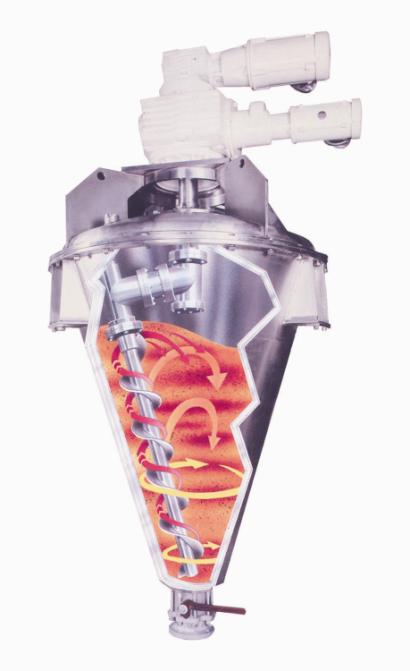Tech Report
Large-scale vacuum drying in a Vertical Blender

Technology Brief
This bulletin discusses the benefits of large-scale drying in Vertical Blender/Dryers.
Advantages of Vertical Blender/Dryers
Vertical Blender/Dryers feature a slow-turning auger screw orbiting a vacuum-rated conical vessel. As it turns, the screw gently lifts material upward and towards the center of the batch. At the same time, product from the top cascades back to the bottom while mixing with materials being moved upward by the orbiting screw. During the drying cycle, hot water, oil or steam is recirculated through the vessel jacket and vacuum is typically applied. Requiring relatively low temperatures to drive off moisture or solvents, vacuum drying is an excellent method for processing heat-sensitive formulations without fear of thermal degradation. Energy consumption is also minimized.
As opposed to conventional ovens and tray dryers where product is stationary, the layer of material contacting the Vertical Blender`s heated sidewalls is constantly being renewed which, coupled with vacuum conditions, leads to significantly shorter drying rates. Another drying technology available to manufacturers is spray drying where an atomizer breaks up the feed into fine droplets and hot air forces the liquid components to evaporate, leaving behind solids with a uniform particle size. While this process is fast and can be operated continuously, high energy and pressure requirements, as well as maintenance issues, make it impractical for some applications.
Low-maintenance drying system
Most well-designed Vertical Blender/Dryers are offered with a fully top-supported screw agitator. Without a bottom support bearing to get in the way, discharge of the dried materials is efficient and complete, while the machine itself requires very low maintenance. Material build-up and batch-to-batch contamination are further prevented by having polished interior surfaces and a large enough discharge valve(same diameter as the screw, if possible).
Due to its vessel shape, even a large-scaleVertical Blender/Dryer occupies minimal floorspace. Feed materials are pumped or manually charged through ports or manholes in the vessel cover. The cone and screw are easily cleaned in place by spraying water or cleaning solution which would drain completely as the mixer is allowed to air dry.
Vertical Blender/Dryers offer exceptional flexibility in terms of batch size - special orders and test runs as small as 10% of the rated capacity can be dried without destroying any friable or shear-sensitive materials.
How a Vertical Blender/Dryer works:

Heat is applied to the jacketed vessel of the vertical blender.Once vacuum is established, the combination of low absolute pressure, gentle heat and slow agitation quickly forces moisture from the bulk material. The vapors generated in the process pass through a filter and into a condenser. A receiver collects the condensed liquids for re-use or proper waste disposal. At the end of the drying cycle, the finished product is discharged completely through the bottom valve of the vertical blender/dryer.
Sample Application: High-purity Ceramic Powders
A manufacturer of inorganic chemicals is using 200- and 300-cu.ft. RossVertical Blender/Dryers for processing different types of ceramic materials.Initial scale-up data were gathered from testing a 1-cu.ft. VerticalBlender/Dryer at the Ross Test & Development Center. In one test, a low viscosity slurry containing zirconium oxide was charged into the vacuum blender and virtually all the solids were recovered in the form of dry granules in less than 3 hours. The company also rented a similar 10-cu.ft. VerticalBlender for further testing on the actual process floor.
The drying trials provided a baseline for expected drying times, optimum vacuum level and anticipated power draw. These parameters allowed Ross engineers to properly size the motors on the large-scale blenders and gave the user enough information to make an informed comparison with other drying technologies. Based on the quality of the dried powders produced in theVertical Blender/Dryer and the overall efficiency, the manufacturer was able to confirm that this was the best technology for their high-volume needs.